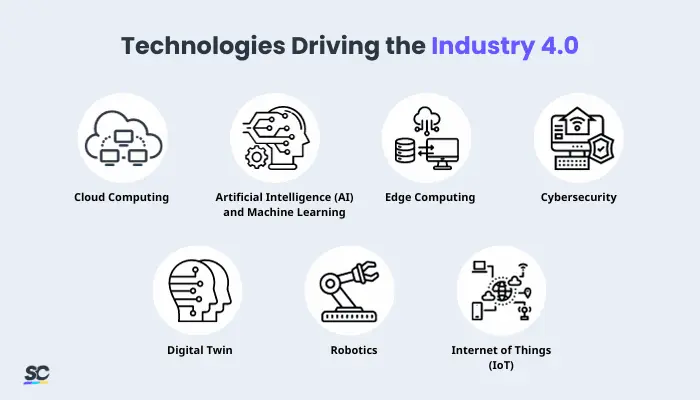What is Industry 4.0?
Industry 4.0 refers to the revolution that transforms manufacturing, design, and operations by combining digital and physical technologies. Also known as the fourth industrial revolution, Industry 4.0 technologies include 3D printing, robotics, artificial intelligence, and the Internet of Things (IoT). These technologies make it possible for factories to produce customized products at a mass scale. They are also enabling new business models and organizational structures. For example, some companies use 3D printing to create customized parts on demand without needing inventory or warehousing.
Industry 4.0 is also changing how factories are designed and operated. For example, many factories are now using data analytics to optimize production processes. As these technologies continue to develop, they are likely to impact the economy and society profoundly.
History
Here’s a brief overview of the different industrial revolutions:
First Industrial Revolution
The first industrial revolution in Britain began in the late 18th century. It helped factories mass produce goods using water and steam power instead of human and animal labor. Instead of all products being handcrafted, finished products were made by machines.
Second Industrial Revolution
A hundred years after the first industrial revolution, a second one began with assembly lines and oil, gas, and electricity. Manufacturing processes became more automated with these new power sources and communication advancements like the telephone and telegraph.
Third Industrial Revolution
Throughout the 20th century, the third industrial revolution added computers and data analysis to manufacturing processes. This digitization of factories started by incorporating Programmable Logic Controllers (PLCs) into machinery for automating some processes and collecting and sharing data.
Benefits
Industry 4.0 encompasses not only the product life cycle and supply chain but also design, sales, inventory, scheduling, and quality control engineering—to name a few fields. Furthermore, it provides real-time analytics that is reliable and accurate. This is all possible because everyone has access to informed data regarding production processes and business procedures.
Here are some benefits of adopting an Industry 4.0 model for your business:
Intelligent Products
Products that are aware of their surroundings and can share information about things like their health, location, how often they’re used, and more. This data can help improve customer service, product quality, logistics, and research and development.
Smart products can also predict when they’ll need servicing and receive upgrades remotely, which could lead to new business models based on services.
Intelligent Factories
Smart factories are digitized, have autonomous facilities, and use advanced technologies like Big Data, Artificial Intelligence (AI), robotics, analytics, and the IoT. Factory 4.0 is another name for them.
These plants can fix themselves by employing smart manufacturing processes 4.0 and making it possible to deliver customized products cheaply and on a large scale.
Intelligent Assets
IoT and analytics are built into almost every physical asset today. With these intelligent assets, technicians can:
- monitor asset performance in real-time;
- anticipate and prevent downtime;
- employ dynamic and predictive maintenance;
- take advantage of digital twins; and
- tightly integrate assets and business processes.
Empowered People
Even with the most advanced systems, you will always need people. Give them access to AI and live sensor data to monitor what is happening on the production floor and make quick decisions when needed. Wearable devices and augmented reality apps can help solve problems, stay healthy, and remain safe.
What Technologies are Driving Industry 4.0?

Cloud Computing
A crucial element of any Industry 4.0 plan is cloud computing. A smart manufacturing process integrates engineering, supply chain, production, sales, and distribution. Cloud makes it possible to store and analyze data more efficiently.
Additionally, cloud computing can help small- and medium-sized manufacturers reduce startup costs because they can scale as their business grows.
Artificial Intelligence (AI) and Machine Learning
Manufacturing companies can use AI and machine learning to utilize all the data generated by partners and third parties across their business units. These technologies can provide visibility, predictability, and automation of operations and business processes. For example, factories’ machinery regularly stops working while in use.
By gathering data from these assets and employing predictive maintenance through machine learning algorithms, businesses can reduce this downtime and be more productive.
Edge Computing
Data analysis needs to occur at the point where the data is created, called the “edge.” For example, edge computing would enable quicker responses if a safety or quality issue arose. Relying on sending data to an enterprise cloud and then back again may be too lengthy of a process and depend on how reliable the network connection is. With edge computing, fewer data travel in the network, reducing potential security risks.
Cybersecurity
In the past, many manufacturing companies have overlooked cybersecurity and cyber-physical systems. However, now that operational equipment in factories or fields is constantly connected, this increases the efficiency of processes but also creates new opportunities for malicious attacks.
From a cybersecurity perspective, a complete understanding of Information Technology (IT) and Operational Technology (OT) equipment is more important than ever in transforming to Industry 4.0.
Digital Twin
Industry 4.0’s digital transformation has allowed manufacturers to create digital clones that are virtual replicas of their processes, production lines, factories, and supply chains. These twins are created by taking data from internet-connected objects such as IoT sensors and PLCs.
Digital twins benefit manufacturers in many ways, from maximizing productivity to workflow improvements to help with designing new products. By digitally simulating a production process, for example, you can experiment with different changes to find the most efficient way of running things with minimal downtime and maximum output capacity.
Robotics
Manufacturing operations already use robots, but many see them as future technologies. Automation and robotics can help with repetitive tasks, freeing humans from more complex work. Automating the production line will also allow robots to perform specific tasks together with humans.
It’s also possible to use them in dangerous conditions for people to enter, and they can be programmed to detect and fix errors quickly. It’s all done with the help of sensors, cameras, and other technologies that give them increased accuracy and safety.
Internet of Things
Equipping machines on the factory floor with sensors that feature an IP address allows for the Internet of Things (IoT) in smart factories. This connectivity makes it possible to collect, analyze and exchange large amounts of data.
Digitize the way you Work
Empower your team with SafetyCulture to perform checks, train staff, report issues, and automate tasks with our digital platform.
Get Started for FreeExamples of Industry 4.0 Technologies
IoT in Manufacturing
The use of IoT in manufacturing can increase production throughput by removing bottlenecks. Machines with IoT devices can collect data about their efficiency, usage, and uptime on a production floor. A machine learning algorithm can analyze this data to identify which machines are bottlenecks and how to fix them—for example, upgrading the machine or increasing its efficiency during the day.
Cybersecurity in Manufacturing
If manufacturers want to protect themselves from thieves stealing their intellectual property or hackers commandeering their equipment to sabotage production, they need digitized smart systems with comprehensive cybersecurity.
Manufacturers can reduce the likelihood of becoming victims of these devastating security threats by taking proactive measures—such as having a breach plan and implementing protective data safeguards.
Digital Twins in Manufacturing
A manufacturing company can use industrial IoT sensors to have a virtual replica of its entire shop floor. It lets them see every asset’s location, uptime, and maintenance needs in real-time. They can even peek inside machines that would be too dangerous or costly to open physically.
FAQs About Industry 4.0
Data exchange between systems must be instantaneous for Industry 4.0 to be realized. Automation will replace time-consuming and error-prone manual processes. New opportunities open if the systems can request data that changes based on the situation. For example, if a company unexpectedly runs out of raw materials, the company can call up different production orders to stay on schedule.
Although “smart factory” and “smart manufacturing” are phrases used worldwide, “smart industry” is more commonly employed in specific countries. It’s a synonymous term for Industry 4.0, also called Industrial Internet or Industrial Internet of Things.
Digitalization results in a change in how production, logistics, communication, and human resource management works. Innovative approaches that use connected smart devices are essential to make the most of digitalization’s potential to establish new ways of communicating and working together.
One of the most pivotal ways Industry 4.0 will affect the job market is by taking over numerous positions in high-risk industries, such as manufacturing, agriculture, industrial, and construction sites.
The probability for automation to take these roles has increased because many involve mind-numbing repetition or are too dangerous for humans. Automating them would reduce errors and increase productivity.
Industry 4.0 provides new and enhanced opportunities for how businesses operate and grow. At the same time, it raises concerns about the possibility of technology and robots replacing employees in the workplace.
The biggest obstacle to adopting Industry 4.0 in daily operations is the resistance to change. Aside from that, if there’s no clear strategy and plans on how to enforce this approach in business functions, it can lead to ineffective implementation.




